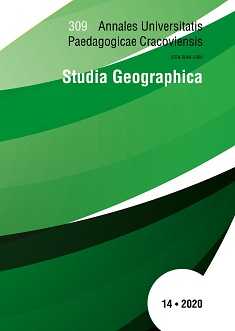The use of photography in contemporary geographical education: teaching assumptions and practical solutions
DOI:
https://doi.org/10.24917/20845456.14.3Keywords:
activation; didactical photography; geographical education, photography, observationAbstract
Direct and indirect observations are the base of geographical education and creating of knowledge. The observations begin with the shaping of concepts and terms, they are the source for formulating regularities and the basis for classification. In science and geography education, observations are particularly important, only the quality of observational materials that can be used in the lesson, the source of illustrations and the media enabling the observation is changed. The aim of the paper is to characterize the types of photography along with the didactic commentary on their correct use in geographical education. It is a theoretical and application paper in which the set aim has been achieved using interdisciplinary studies of literature, practice in taking photographs and using them in teaching geography.
References
Barrett, T. (1986). Part III Teaching about Photography: Types of Photographs. Art Education, 39(5), 41–44.
Bieniek, M. (2007). Dydaktyka historii. Wybrane zagadnienia. Olsztyn: Wydawnictwo Uniwersytetu Warmińsko-Mazurskiego.
Hallada, M. (2013). Fotografia dydaktyczna w programie multimedialnym i podręczniku „Śladami historii” dla klasy pierwszej gimnazjum, (w:) Morbitzer J., Musiał E., (red.) Człowiek – Media – Edukacja. Kraków: Wyd. UP, 129–136.
De Bono, E. (2008). Sześć kapeluszy myślowych. Gliwice: Wyd. Helion.
Langford, M. (1998). Advanced photography. Focal Press.
Litwic-Kamińska, K. (2011). Kultura obrazkowa w dydaktyce – szanse i zagrożenia. Forum Dydaktyczne: przeszłość, teraźniejszość, przyszłość, 7/8, 177–188.
Łosiewicz, M. (2009). Rola obrazu w komunikacji społecznej. W: A. Obrębska (red.), Komunikacja wizualna w przestrzeni społecznej. Łódź: Wyd. Primum Verbum, 205–212.
Napierała-Rydz, K. (2016). Fotografia w edukacji. Wykorzystanie fotografii w nauczaniu historii. Kraków: Wyd. Libron.
Piróg, D. (2015). ZAMEK. Rozpoznawanie predyspozycji zawodowych. Materiały metodyczno-informacyjne i narzędzia dla nauczycieli, doradców zawodowych, psychologów, pedagogów i rodziców. Warszawa: Wyd. Nowa Era.
Piróg, D. (2019). Edukacja geograficzna oraz przyrodnicza przez dociekanie – koncepcja i zastosowanie w praktyce szkolnej. Geografia w Szkole, 5, 26–30
Piskorz, S. (red.). (1997). Zarys dydaktyki geografii. Warszawa: Wyd. PWN.
Roberts, M. (2013). Geography through inquiry. Approaches to teaching and learning in the secondary school. Sheffield: Geographical Association.
Rose, G. (2008). Using photographs as illustrations in human geography. Journal of Geography in Higher Education, 32(1), 151–160.
Rothenberg, T.Y. (2016). Presenting America’s World: Strategies of Innocence in National Geographic Magazine, 1888–1945. Routledge.
Sontag, S. (1986). O fotografii. Warszawa: Wyd. Artystyczne i Filmowe.
Suchoński, A. (1994). Środki dydaktyczne w nauczaniu-uczeniu się historii. W: J. Maternicki, Cz. Majorek, A. Suchoński (red.), Dydaktyka historii. Warszawa: Wyd. PWN.
Sze Onn, Y. (1983). Pictures as teaching tools in geography. Teaching and Learning, 4(1), 5–13.
Triacca, S. (2017). Teaching and Learning with Pictures The Use of Photography in Primary Schools. International and Interdisciplinary Conference IMMAGINI? Image and Imagination between Representation, Communication, Education and Psychology, Proceedings 1(9), 952; https://doi.org/10.3390/proceedings1090952
Wojtanowicz, P. (2014). Percepcja materiału ilustracyjnego z geografii i przyrody –rozbiór na czynniki pierwsze. Annales Universitatis Paedagogicae Cracoviensis Studia Geographica, 6, 242–260.
Downloads
Published
Issue
Section
License
The submission of a paper to be published is synonymous with an agreement to transfer the copyright free of charge from the author to the publisher. The author also agrees to permit the publisher to publish the paper in printed form, open access online form, digital library form and other digital platforms with which the publisher has or will have a publishing agreement. Furthermore, the author agrees to not limit the number of copies that may be printed or issued by the publisher. In the case of co-authored papers, it is assumed that the corresponding author is authorized to represent the remaining co-authors in this respect. Authors are requested to sign a copyright declaration.

